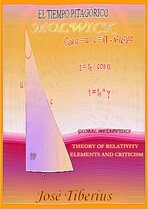2.c.4. Theory of light
This section studies the theory of light from its essential physical nature. In other words, the characteristics derived from what is light as electromagnetic energy and its behavior or fundamental relations with other concepts of Modern Physics, such as kinetic energy, mass, and gravity.
A curiosity of relativistic physics is the non-understanding of the nature of light, as it does not explain why the speed of light is a maximum; it merely imposes it as a mathematical axiom. What is worse, there is an evident confusion about this maximum because one can read many times that it has been experimentally confirmed.
When Theory of Relativity came out, it could have made sense given the little experience that they had in that era; but after a century of scientific development, it seems strange that Modern Physics still does not explain what light is and what the origin of the speed limit is. The wave-particle duality of light is nothing more than a way of recognizing that the concept of light, some of its characteristics and its nature are still unknown.
No doubt, Modern Physics is in a state of change. The search for a unification theory or a theory of everything, which explains what light is and it manages to make Quantum Mechanics compatible with Einstein’s theory or substitutes both theories, is a topic evermore present in the scientific environment and the media.
The lack of a concept of light is obvious within Modern Physics. On the one hand, the Theory of Relativity is an abstract and mathematical theory, and on the other, Quantum Mechanics has renounced to explain the reason for Heisenberg’s Uncertainty or Indeterminacy Principle, significantly conditioned by the aspects supposedly proved by Einstein’s theories.
In Modern Physics, one can talk of dark something, quantum something, or double nature of something meaning its nature is unknown.
The following points deal with the characteristics of light from Relativity, Quantum Mechanics, and Global Physics.
The first point relates to what light is from the perspective of its material reality, the relation of light with mass and its main characteristic of being energy.
Although it is difficult to separate some properties of light from others, the second point deals with the nature and characteristics of light regarding velocity.
The books Global Mechanics and Physics and Global Dynamics contain an explanation in depth of these two points within the new paradigm of Global Physics.
2.c.4.a) What is light?
In order to understand the concept of light, let us analyze the following elements and essential relations separately:
Material support of electromagnetic energy
The wave-particle duality of light is one of the least understood characteristics. On the one hand, its wave nature is indubitable given interference phenomena. On the other, the behavior of light as a particle, as deduced from the photoelectric effect, is intriguing because I do not see anything unusual or any particle in a vibration on a table that makes a ball jump over a small barrier.
The unknown variable is still the eternal question of what light is, and whether or not it has mass. According to relativistic physics and Quantum Mechanics, a photon of light is a massless particle – it must be a different way of saying a wave. Of course, another problem, Modern Physics does not know what mass is, and so on. The concept of light as an abstract and generic particle seems to be more philosophical than scientific.
An adequate definition of light of Modern Physics is a mathematical or abstract force field that automatically reproduces in free space. Afterwards, there are all types of singularities, uncertainties, and versions, from time travel to effects of other dimensions.
The lack of a clear concept of light and mass is worsened with Einstein’s famous equation –originally from Olinto de Pretto– of the transformation of mass to energy and vice versa E = m c². The brain ends up believing it, and it seems that they are always interchangeable.
Hat galaxy in infrared - NASA (Public domain image) 
However, for Global Physics, the concepts of light and mass are very different, despite having a common characteristic, to be manifestations of the elastic energy of the reticular structure of matter or Global Aether.
In other words, the meaning of Einstein’s equation of transformation between mass and energy is the transformation from one type of energy to another. Quite the contrary, other characteristics of light not included in the equation above are different to those of mass, as light and mass are two different concepts in Global Physics.
Gravitation in relativistic physics does not detect that, in the process of transformation from one type of energy to another, other alterations occur. In other words, the reticular structure of matter transforms and changes its energy properties.
The new theory is intelligible with the usual meanings of the words energy and mass. On the one hand, from the concept of light that we all have, we deduce that it is a property of matter in general; that is to say, energy is a property of something physical. The definition of light or energy on Wikipedia goes the same way, although it gets messy when using the word system.
On the other hand, the meaning of mass relates directly to an element of physical or material reality.
Moreover, the concept of energy itself involves mass, acceleration (time) and the distance traveled as independent magnitudes or units in its definition. In other words, the magnitude m refers to something physical, and time and space contained in acceleration and distance magnitudes are properties of the physical reality.
Light in phenomena of creation of mass and wavine
Mass, for the Standard Model of Quantum Mechanics, is a mystery; and, even now with the Higgs particle that is supposed to bring the mass to particles with mass, the mystery continues.
In Global Mechanics, mass is reticular matter compressed due to the electromagnetic energy or transversal torsion energy on the Global Aether. In this way, the torsion energy transforms into reversible compression energy and tension of the longitudinal curvature or gravitational potential energy.
Wavine is a type of unstable mass, which corresponds to electrons. In order to travel from one orbit to another, electrons become electromagnetic energy, until the reticular structure of matter compresses again, relaxing the differences of transversal tension, and attaining a new gravito-magnetic equilibrium point.
The theory of everything incorporates a new atomic theory with the above characteristics of electrons.
Difference between light or electromagnetic energy and kinetic energy
Modern Physics does not explain what kinetic energy is and whether it is mass or some other abstract and mathematical force. Given its equations, one would say that it relates to an increase of mass with velocity, and that is about it.
The reticular mechanism of kinetic energy in Global Dynamics is a bit harder to explain or understand. To grasp this concept, one must accept, take into account, or internalize the above characteristics of light and mass.
Many experiments confirm the increment in relativistic mass with kinetic energy, living aside the concept of invariant mass, of course.
